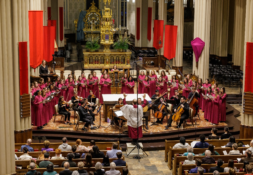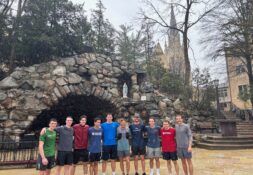As we have all just returned from a week outside the bubble, I thought it appropriate to devote this article to the state of traditional buildings in the broader architectural world. Over the break, I had the privilege of attending the Traditional Building Show and Conference in Chicago. Held annually by Restore Media, the publisher of a number of trade- and consumer-oriented magazines about traditional construction, the show brings together manufacturers, architects, contractors, and city officials to discuss approaches to work on both historic and new projects.
The topics covered ranged from technical matters (application of glazing putty to steel windows) to the overarching philosophies of building in traditional methods and styles. In the latter category, Professor Steven Semes of the Notre Dame School of Architecture outlined the arguments put forth in his recent book, The Future of the Past. This book challenges some of the conventional modernist approaches to dealing with projects in historically sensitive areas. The academic director of our Rome Studies Program, Professor Semes will be on campus this week for the durability conference being held at the School of Architecture. (The colloquium will feature an international panel of speakers and is open to all, so be sure to stop by Bond Hall this week.)
While in Chicago, I attended a number of sessions on the green economy and the efficiency of historic homes. These discussions were remarkably upbeat, given the recent economic difficulties. There is a hopeful attitude that this recession, especially because of its linkage to the housing stock in this country, can serve as a wake-up call to the practices of wanton sprawl and a renewed appreciation for the existing, serviceable communities that have been neglected by the developers of exurban McMansions. I am also pleased to report, based on a highly scientific analysis of the banter among attendees, that ‘Dubai’ is now, officially, a punchline.
Another subject of interest is the adaptive reuse and restoration of historic religious structures. The Traditional Building Conference featured a presentation on three centuries of sacred architecture in Rhode Island. Beginning with a historical overview of the contribution of Rhode Island to religious freedom in the United States, the firms proceeded to discuss recent projects in the vicinity of Newport, on Aquidneck Island. These included the conversion of a 19th century meetinghouse into residential units, the restoration of a mid-20th-century modern chapel at a Benedictine boarding school, and the new construction of a chapel for Salve Regina University. Nestled among the palatial ‘cottages’ of the Robber Barons, Salve Regina has become a shining example of adaptive reuse by transforming the estates into dormitories and academic facilities.
St. Gerard’s, a church in Buffalo, New York, has also been in the news recently. The historic church, based on the Basilica of St. Paul-outside-the-walls in Rome, was facing closure due to declining population in the rust belt city. Arrangements are now being made to transport it to Atlanta, Georgia, where it will be reassembled for a new, fast-growing parish. Under the direction of Professor Aimee Buccellato, the School of Architecture here is using it as a case study for its Green Scale Research Project. The students and faculty involved in this research are working to develop a quantifiable database comparing traditional and restoration work to conventional modern practices for new construction.
This is a period of tremendous opportunity for those of us in the architectural field, as well as for all who inhabit and love traditional buildings. The arguments for building durable, practical, and beautiful buildings that contribute to a local character and sense of history have never been better. I am proud to be able to say that the University of Notre Dame’s School of Architecture is engaging the broader building culture to continue this trend into the future.
Matthew Balkey is a 4th year architecture student. His theme song is the Hallelujah Chorus from Handel’s oratorio Messiah. Contact him at mbalkey-at-nd.edu.





